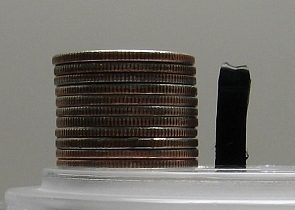Home > Press > The Longest Carbon Nanotubes You've Ever Seen
 |
| Researchers at the University of Cincinnati have grown the world's longest carbon nanotube arrays, long enough to be seen by the naked eye. Credit: V. Shanov, M. Schulz, University of Cincinnati |
Abstract:
Crafted with breakthrough manufacturing technique, centimeter-long fibers are visible to the naked eye.
The Longest Carbon Nanotubes You've Ever Seen
Cincinnati, OH | Posted on May 10th, 2007Using techniques that could revolutionize manufacturing for certain materials, researchers have grown carbon nanotubes that are the longest in the world. While still slightly less than 2 centimeters long, each nanotube is 900,000 times longer than its diameter.
The fibers--which have the potential to be longer, stronger and better conductors of electricity than copper and many other materials--could ultimately find use in smart fabrics, sensors and a host of other applications.
To grow the aligned bundles of tiny tubes, the researchers combined advantages of chemical vapor deposition (CVD), a technique for creating thin coatings that is especially common in the semiconductor industry, with a novel substrate and catalyst onto which the carbon attaches.
Supported by the National Science Foundation (NSF) and the Office of Naval Research, University of Cincinnati (UC) professors Vesselin Shanov and Mark Schulz collaborated with post-doctoral researcher Yun Yeo Heung and students to develop the technique.
The researchers partnered with First Nano, a division of CVD Equipment Corp. of Ronkonkoma, N.Y., to use their laboratory and a specialized furnace called the EasyTube 3000. With the equipment, the researchers were able to break apart hydrocarbons to create a vapor of carbon-atom starting material. Within the vapor sat the new substrate--a catalyst made of alternating metal and ceramic layers atop an oxidized-silicon wafer base--which served as the foundation for growth.
"This process is revolutionary because it allows us to keep the catalyst 'alive' for a long period of time thus, providing fast and continuous transport of the carbon 'building blocks' to the carbon nanotube growth zone," said Shanov.
The carbon nanotubes are extremely long compared to predecessors--the longest is 3 millimeters beyond the prior world record. More important for manufacturing, the research team grew a 12-millimeters-thick, uniform carpet of aligned carbon nanotubes on a roughly 10-centimeter silicon substrate, opening the door for scaling-up the process.
The inventions were presented in April 2007 at the Single Wall Carbon Nanotube Nucleation and Growth Mechanisms workshop organized by NASA and Rice University. The research was supported by NSF grant 0510823, in addition to support from the Office of Naval Research through North Carolina A&T SU.
Additional information is available in the University of Cincinnati press release at: http://www.uc.edu/news/NR.asp?id=5700
####
About National Science Foundation
The National Science Foundation (NSF) is an independent federal agency that supports fundamental research and education across all fields of science and engineering, with an annual budget of $5.91 billion. NSF funds reach all 50 states through grants to nearly 1,700 universities and institutions. Each year, NSF receives about 40,000 competitive requests for funding, and makes nearly 10,000 new funding awards. The NSF also awards over $400 million in professional and service contracts yearly.
Receive official NSF news electronically through the e-mail delivery and notification system, MyNSF (formerly the Custom News Service). To subscribe, visit www.nsf.gov/mynsf/ and fill in the information under "new users".
Useful NSF Web Sites:
NSF Home Page: http://www.nsf.gov
NSF News: http://www.nsf.gov/news/
For the News Media: http://www.nsf.gov/news/newsroom.jsp
Science and Engineering Statistics: http://www.nsf.gov/statistics/
Awards Searches: http://www.nsf.gov/awardsearch/
For more information, please click here
Contacts:
Media Contacts
Joshua A. Chamot, NSF (703) 292-7730
Wendy Beckman, University of Cincinnati (513) 556-1826
Program Contacts
Shih Chi Liu, NSF (703) 292-7017
Jimmy Hsia, NSF (703) 292-7020
Mihail C. Roco, NSF (703) 292-8301
Co-Investigators
Mark Schulz, University of Cincinnati (513) 556-4132
Vesselin Shanov, University of Cincinnati (513) 556-2461
Copyright © National Science Foundation
If you have a comment, please Contact us.Issuers of news releases, not 7th Wave, Inc. or Nanotechnology Now, are solely responsible for the accuracy of the content.
| Related News Press |
Nanotubes/Buckyballs/Fullerenes/Nanorods/Nanostrings
![]() Enhancing power factor of p- and n-type single-walled carbon nanotubes April 25th, 2025
Enhancing power factor of p- and n-type single-walled carbon nanotubes April 25th, 2025
![]() Chainmail-like material could be the future of armor: First 2D mechanically interlocked polymer exhibits exceptional flexibility and strength January 17th, 2025
Chainmail-like material could be the future of armor: First 2D mechanically interlocked polymer exhibits exceptional flexibility and strength January 17th, 2025
![]() Innovative biomimetic superhydrophobic coating combines repair and buffering properties for superior anti-erosion December 13th, 2024
Innovative biomimetic superhydrophobic coating combines repair and buffering properties for superior anti-erosion December 13th, 2024
Announcements
![]() Rice membrane extracts lithium from brines with greater speed, less waste October 3rd, 2025
Rice membrane extracts lithium from brines with greater speed, less waste October 3rd, 2025
![]() Researchers develop molecular qubits that communicate at telecom frequencies October 3rd, 2025
Researchers develop molecular qubits that communicate at telecom frequencies October 3rd, 2025
![]() Next-generation quantum communication October 3rd, 2025
Next-generation quantum communication October 3rd, 2025
![]() "Nanoreactor" cage uses visible light for catalytic and ultra-selective cross-cycloadditions October 3rd, 2025
"Nanoreactor" cage uses visible light for catalytic and ultra-selective cross-cycloadditions October 3rd, 2025
|
|
||
|
|
||
| The latest news from around the world, FREE | ||
|
|
||
|
|
||
| Premium Products | ||
|
|
||
|
Only the news you want to read!
Learn More |
||
|
|
||
|
Full-service, expert consulting
Learn More |
||
|
|
||








